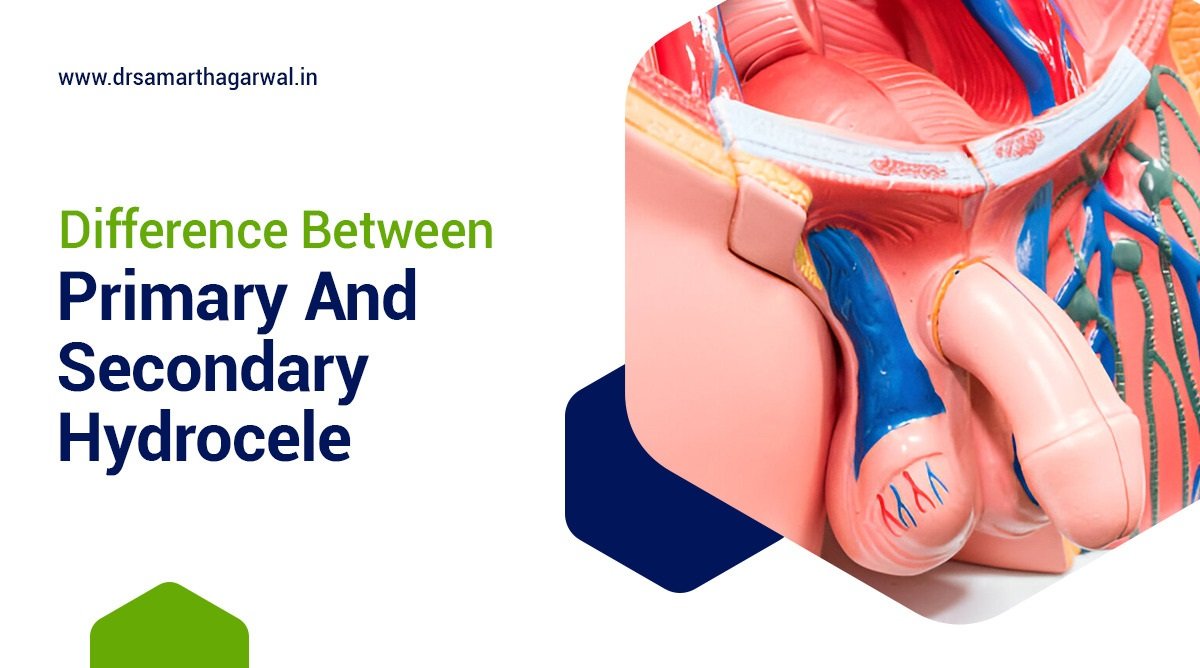Hydrocele is a medical condition characterized by the accumulation of serous fluid within the tunica vaginalis, the protective sheath surrounding the testis in the scrotum. This fluid buildup can cause noticeable scrotal swelling and discomfort. While the general definition remains consistent, hydroceles are categorized into two main types: primary and secondary.
The key differences between primary and secondary hydrocele lie in their underlying causes, onset, and associated symptoms. Primary hydrocele typically occurs due to developmental issues, often presenting in infancy or childhood, and is generally painless. In contrast, secondary hydrocele results from underlying pathological conditions such as testicular tumors or infections, can occur at any age, and is frequently accompanied by pain.
Treatment options for these two types of hydrocele vary based on their distinct characteristics. Primary hydrocele may be managed through observation for asymptomatic cases or surgical intervention for more severe instances. Secondary hydrocele treatment focuses primarily on addressing the underlying cause, which may involve infection treatment or surgical procedures to alleviate symptoms and prevent complications.
Understanding these differences is crucial for accurate diagnosis and effective management of hydrocele. The following detailed comparison provides a comprehensive overview of primary and secondary hydrocele, their distinguishing features, and appropriate treatment approaches.
What Is a Hydrocele?
A hydrocele is a medical condition characterized by the accumulation of serous fluid within the tunica vaginalis, the protective sheath surrounding the testis in the scrotum. This fluid buildup can lead to noticeable scrotal swelling, often causing discomfort or anxiety for those affected. Hydroceles can occur in various forms and may be congenital, appearing at birth, or acquired later in life.
Understanding hydrocele is essential for identifying its types, causes, symptoms, diagnosis, and treatment options, particularly as the condition may affect both pediatric and adult patients differently.
What Are the Types of Hydrocele?
Hydroceles can be categorized into two main types: primary hydrocele and secondary hydrocele, each with distinct characteristics and underlying causes that influence treatment options and patient outcomes.
Primary Hydrocele
Primary hydrocele refers to a type of hydrocele that arises without any underlying pathological conditions, often occurring due to developmental issues in the tunica vaginalis, leading to fluid accumulation that causes noticeable scrotal swelling.
This condition usually manifests in infancy or early childhood and can be linked to a variety of congenital conditions that may affect the normal anatomy of the scrotum. Typically, affected individuals experience symptoms such as:
- Swelling in one or both testicles
- Discomfort or heaviness in the scrotum
- Changes in the size of the swelling depending on activity level and time of day
Diagnosis is often straightforward, as a physical examination usually suffices to identify the distinctive scrotal swelling. In some cases, a scrotal ultrasound may be conducted to confirm the presence of fluid. Individuals with primary hydrocele generally lead normal lives; however, they may need to adjust certain physical activities to manage discomfort. Timely intervention, including prenatal diagnosis for congenital hydrocele, can alleviate symptoms and prevent complications, emphasizing the importance of understanding this condition.
Furthermore, early diagnosis and proper management strategies can significantly enhance the quality of life for those affected.
Secondary Hydrocele
Secondary hydrocele is related to underlying conditions such as testicular tumors, epididymo-orchitis, or trauma to the testis, resulting in fluid accumulation due to inflammation or disruption in the lymphatic system.
Understanding the causes and risk factors for this condition is crucial for effective management. While primary hydrocele may occur without any identifiable reason, secondary hydrocele often stems from significant medical issues that require attention. For instance, testicular tumors can obstruct lymphatic pathways, effectively leading to this painful accumulation. Infections, such as: epididymo-orchitis can cause the testicular tissue to become inflamed, which might also contribute to fluid build-up.
Trauma to the testis, whether a recent injury or a surgical complication, can elevate the risk of developing a hydrocele. In these cases, the inflammatory response can disrupt normal fluid drainage from the scrotum, necessitating careful evaluation through diagnostic techniques such as a scrotal ultrasound. Infection treatment and surgical treatment may be required based on the severity and underlying causes.
Risk Factors Include:
- History of testicular conditions
- Recent surgeries or trauma
- Infections such as sexually transmitted diseases
Recognizing these connections is vital, as it not only assists in diagnosing the hydrocele accurately but also guides the treatment approach.
What is the Difference between primary and secondary hydrocele?
Understanding the differences between primary and secondary hydrocele is crucial for proper diagnosis and treatment. The following table provides a comprehensive comparison of these two types of hydrocele, highlighting key aspects such as causes, symptoms, diagnosis, and treatment options. This at-a-glance overview will help you quickly grasp the distinctive features of each type:
| Aspect | Primary Hydrocele | Secondary Hydrocele |
| Definition | Accumulation of serous fluid within the tunica vaginalis without underlying pathological conditions | Accumulation of serous fluid within the tunica vaginalis due to underlying conditions |
| Cause | Developmental issues in the tunica vaginalis, often congenital | Underlying conditions such as testicular tumors, epididymo-orchitis, testicular trauma, or lymphatic filariasis |
| Age of Onset | Often in infancy or early childhood | Can occur at any age, more common in adults |
| Symptoms | – Painless scrotal swelling- Swelling in one or both testicles- Discomfort or heaviness in the scrotum- Changes in swelling size depending on activity and time of day | – Scrotal swelling- Pain, especially if linked to epididymo-orchitis or testicular trauma- Symptoms related to underlying conditions |
| Pain Level | Typically painless unless complications arise | Often painful due to underlying conditions |
| Types | Can be communicating or non-communicating hydrocele | N/A |
| Diagnosis | – Physical examination- Scrotal ultrasound to confirm fluid accumulation- May include prenatal diagnosis for congenital cases | – Comprehensive evaluation- Scrotal ultrasound to identify fluid accumulation and assess underlying conditions |
| Treatment | – Observation for asymptomatic cases- Surgical treatment for symptomatic cases- Aspiration sclerotherapy- Procedures often performed under local anesthesia | – Focus on addressing underlying causes- Infection treatment if applicable- Surgical intervention to relieve fluid accumulation and symptoms |
| Complications | – Risk of infection- Increased scrotal swelling- Potential discomfort- Risks associated with surgical intervention | – Complications from underlying conditions- Chronic infections- Persistent symptoms- May require more intensive treatments |
| Prevention | – Minimizing risk factors- Avoiding testicular trauma | – Addressing infections promptly- Minimizing risk factors- Avoiding testicular trauma |
| Special Considerations | May affect pediatric patients differently | May be related to conditions such as lymphatic filariasis caused by mosquito-borne parasites in regions like Africa and Southeast Asia |
| Potential for Transformation | N/A | Primary hydrocele can potentially develop into secondary hydrocele if underlying conditions arise |
What Are the Causes of Primary Hydrocele?
The primary hydrocele is often attributed to developmental issues in the tunica vaginalis, leading to a congenital hydrocele, but can also result from other factors affecting the lymphatic system that do not involve secondary conditions.
What Are the Causes of Secondary Hydrocele?
Secondary hydrocele can occur due to various underlying pathological conditions such as testicular tumors, epididymo-orchitis, or testicular trauma, leading to chronic infection and subsequent fluid accumulation within the tunica vaginalis. Conditions related to lymphatic filariasis, caused by mosquito-borne parasites like Wuchereria bancrofti and Brugia malayi, prevalent in regions of Africa and Southeast Asia, may also contribute to fluid buildup.
Secondary hydrocele can occur due to various underlying pathological conditions such as testicular tumors, epididymo-orchitis, or testicular trauma, leading to chronic infection and subsequent fluid accumulation.
What Are the Symptoms of Primary Hydrocele?
Symptoms of primary hydrocele primarily include painless scrotal swelling, which can vary in size and may cause discomfort, though it typically does not present with significant pain unless complications arise. It can manifest as a non-communicating hydrocele or a communicating hydrocele, often observable in pediatric patients.
Symptoms of primary hydrocele primarily include painless scrotal swelling, which can vary in size and may cause discomfort, though it typically does not present with significant pain unless complications arise.
What Are the Symptoms of Secondary Hydrocele?
In contrast to primary hydrocele, secondary hydrocele symptoms can include scrotal swelling accompanied by pain, especially if linked to conditions like epididymo-orchitis or due to testicular trauma. Bilateral hydrocele may also occur in certain cases, requiring careful evaluation.
In contrast to primary hydrocele, secondary hydrocele symptoms can include scrotal swelling accompanied by pain, especially if linked to conditions like epididymo-orchitis or due to testicular trauma.
How Is a Primary Hydrocele Diagnosed?
Diagnosing primary hydrocele typically involves a physical examination followed by a scrotal ultrasound to confirm fluid accumulation within the tunica vaginalis and rule out other conditions.
How Is a Secondary Hydrocele Diagnosed?
The diagnosis of secondary hydrocele often involves a comprehensive evaluation, including scrotal ultrasound, to identify fluid accumulation and assess for underlying conditions such as testicular tumors or infections.
What Are the Treatment Options for Primary Hydrocele?
Treatment options for primary hydrocele typically include observation for asymptomatic cases, while surgical treatment may be indicated for symptomatic hydroceles, often performed under local anesthesia or through techniques like aspiration sclerotherapy.
What Are the Treatment Options for Secondary Hydrocele?
Treatment for secondary hydrocele focuses primarily on addressing the underlying causes, which may involve infection treatment and, in some cases, surgical intervention to relieve fluid accumulation and associated symptoms.
What Are the Complications of Primary Hydrocele?
Complications of primary hydrocele may include the risk of infection, increased scrotal swelling, and potential discomfort, particularly if surgical intervention is required, which can lead to additional risks.
What Are the Complications of Secondary Hydrocele?
Complications arising from secondary hydrocele can result from the underlying conditions, such as chronic infections or testicular trauma, which may lead to persistent symptoms and necessitate more intensive treatments.
Can Primary Hydrocele Turn into Secondary Hydrocele?
While primary hydrocele and secondary hydrocele are distinct conditions, there is a possibility that a primary hydrocele can develop into a secondary hydrocele if underlying conditions such as testicular tumors or epididymo-orchitis arise.
How Can Primary and Secondary Hydrocele Be Prevented?
Preventing hydrocele, whether primary or secondary, often involves minimizing risk factors such as avoiding testicular trauma and addressing infections promptly to reduce the likelihood of fluid accumulation in the scrotum.

If you have any questions or concerns about primary or secondary hydrocele, please contact Dr. Samarth Agarwal for assistance with your urinary health.




